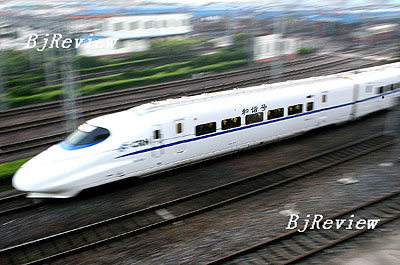
Zhou Xian, a tea shop owner in Shanghai, remembers quite clearly the cover of the newspaper that showed the first high-speed train numbered D460 “flying” along the rail tracks. On April 18, CRH (China Railway High-speed) train D460 made a perfect debut, leaving Shanghai at 5:38 a.m. and arriving in Suzhou 39 minutes later, cutting travel time for the 112-km journey almost in half and ushering in an era of high-speed rail travel in China.
CRH refers to any made-in-China high-speed trains that travel at a speed between 200 and 250 km per hour.
“We all know that time is money, and the speed-up works in our favor, especially when taking a business trip,” said Zhou.
According to experts, the new trains, all made in China, have enhanced safety facilities to ensure stability and safety when traveling at a high speed. In case of emergency, the train can decelerate automatically and stop. Stations serving as CRH train stops have also set up designated booths to make ticket purchases easier and have set aside special waiting rooms for passengers.
The trains are more comfortable than their older counterparts and are fitted with special glass designed not to hurt passengers if shattered.
“It felt like we were traveling on an airplane, “ said one passenger of that first CRH train, 78-year-old Chen Lijuan, a native of Suzhou who lives in Shanghai.
Passengers taking longer trips will notice even more significant timesavings. In central China’s Jiangxi Province, for example, train D96, is a new express service that makes only three stops and runs on improved rails specially designed for high-speed trains.
Liu Jun, a native in Jiangxi’s Nanchang City who works in Hangzhou, says the shortened travel time means she’ll make the trip home more often.
“I normally only return home on holidays, when tickets are hard to get and the trains are crowded,” she said. “Now if I get on the train in the morning, I arrive in the early afternoon. I can go home for a weekend.”
On April 18, 280 CRH trains, or bullet trains, left stations on their first high-speed runs nationwide. By the end of the year there will be more than 500 high-speed trains in service.
Ambition
According to Chinese railway officials, last year China accounted for a quarter of the world’s total railway transport volume, while its rail lines were only 6 percent of the world’s total length.
“The sixth speed-up will boost passenger and cargo transportation capacities by more than 18 percent and 12 percent respectively,” said Hu Yadong, Vice Minister of the Ministry of Railways. The speed boost has put pressure on air travel, with airlines losing their speed edge to a degree.
The new speed boost is the sixth of its kind since 1997, when most trains in China were running at a mere 60 km per hour. As a result, trains will run at speeds of around 200 km per hour and on some sections of track at 250 km per hour, reducing journey time by an average of two hours.
The introduction of CRH trains is a milestone in China’s railway history that also makes the country lead the world in terms of rail technology, along with France, Germany and Japan, which also have high-speed trains.
With the latest speed boost, a fast-speed passenger transportation network centering on hub cities including Beijing, Shanghai and Guangzhou has been formed.
The railway speed boost, according to some transportation experts, will add more competitiveness to railway transportation against road transportation. It will also help to reduce transport costs among the three major economic circles: the Yangtze River Delta, Pearl River Delta and Bohai economic circle.
The Shanghai railway section will see its passenger and cargo transportation capacities increased by 10.9 percent and 12.1 percent respectively, said Liu Lianqing, Director of the Shanghai Railway Bureau. With the latest upgrade there is now a train running between Shanghai and Nanjing every 11 minutes, and between Shanghai and Hangzhou every 15 minutes.
According to He Huawu, Chief Engineer of China’s Ministry of Railways, the overall cost for the sixth railway speed boost stands at 29.6 billion yuan. “The cost is affordable and it’s worth it,” he said.
Apart from increasing passenger and cargo capacity by more than 18 percent and 12 percent respectively, the speed boost will challenge existing railway operations and management patterns and result in railway system reform, said Professor Ji Jialun from Beijing Jiaotong University.
| 